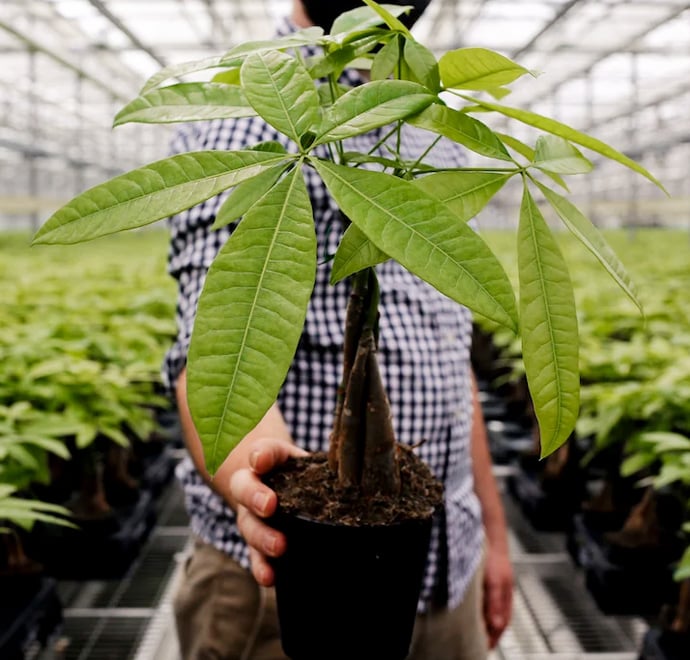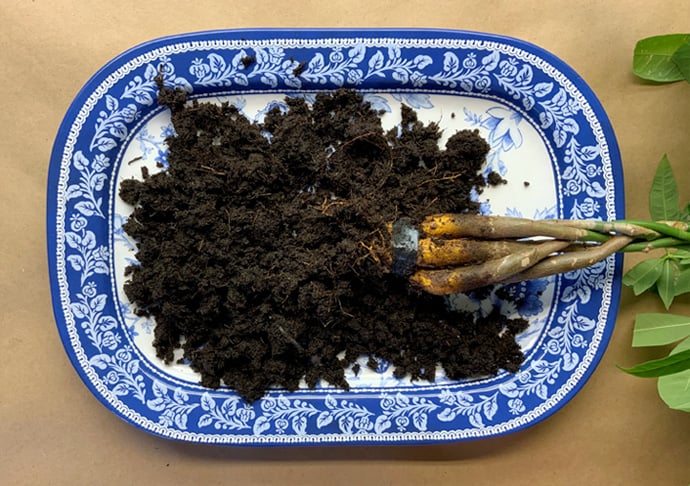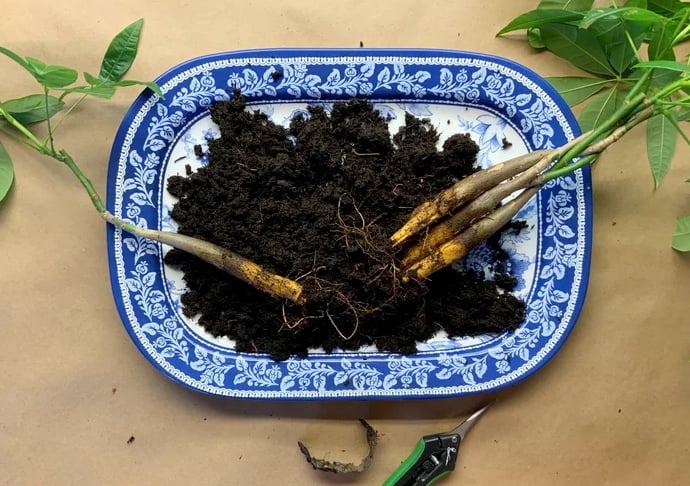
You probably know money trees are legendary for bringing luck and prosperity, but did you know the braided money tree trunk is said to lock in good fortune?
The braided trunk on money trees is actually composed of several smaller trunks, giving this miniature tree its unique appearance.
Even with a lucky, low-maintenance plant, things can still go wrong. One of the main hurdles money tree owners face is what to do when one of the stems in the braided trunk dies.
There are two main causes of money tree trunk failure: dehydration and rot. If either is an issue, not all is lost! Money tree plants are resilient and with proper care, they can bounce back.
The overarching theme here is water. Overwatering and underwatering are two of the main issues plant parents face. Money trees are no different! Both too much water and too little can cause your plant to have issues, mainly in the trunk.
Like many plants, dehydration occurs when a money tree is kept consistently too dry for too long. Stem by stem, the braided trunk begins to shrivel, and its bark begins to peel away.
Why? The water that was stored inside the trunk is being used to help the rest of the plant survive.
Here's the good news: If you notice the symptoms soon enough, the plant can still be saved!
The second cause of trunk failure is rot. Although money trees use moisture efficiently, they can’t always keep up. If the plant sits in too much moisture for too long, it can lead to partial trunk rot.
An easy way to tell if one of the stems in the braid is rotten is to simply give the stem a pinch. If it's mushy to the touch, it contains rot. There may also be a slight smell developing from the rotten plant tissue.
Similar to dehydration, the sooner you notice symptoms the better! If only one or two of the stems are rotten, you may be able to salvage the plant by removing the dead, rotten stems and repotting the plant.
Not sure if your money tree trunk is dead? Check for active growth. Trace all leaf growth back to the original stems in the braided trunk. If one of its stems isn't supporting any leaves, it is likely that part of the trunk is no longer living or is close to death.
In that case, it’s time to take action. Removing dead plant tissue is important to encourage overall plant health and to prevent disease or root rot from developing.
If you have a dead trunk, it’s time to perform tree surgery on your money tree plant.
Don’t worry, this isn't super challenging:
1. Gather supplies. You will need fresh potting mix and a clean container for repotting your money tree plant. Try to find a container that is similar in size to the original if you can. You can also just use the same container after cleaning it with soap and water.
2. Clean tools. While you should be able to accomplish this task for the most part by using your hands, a pair of sterile scissors is necessary to remove the band holding the braided stems together beneath the soil.
If you find other tools are necessary, be sure to use sterilized tools to prevent disease issues. Rubbing alcohol works well to achieve tool sterilization.
3. Remove the plant, potting mix and any debris from its plastic container. Try to pull the potting mix away from the root mass so you can easily separate the dead stem and any rotten roots.
If your plant is struggling with rot, it is likely that the soil will fall away from the trunk as soon as it is removed from the container. Be careful not to damage the other roots.
4. Remove any supports or ties keeping the trunk trained in a braid. Money trees with braided trunks often have been trained this way using a twist tie or twine at the top and bottom of the trunk. This step requires a clean pair of scissors.

5. Carefully, unravel or slip out the dead stem. This is the tricky part, but you should be able to gently separate the dead stem from the others. Take your time—patience is a virtue, especially in this case!
Although damaging a few roots is inevitable, try to avoid tearing/cutting roots when possible. If necessary, you can use a sterilized pair of snips to help untangle the dead part.

6. Discard old potting mix and the dead parts of the trunk. Reusing old potting mix is never a good idea because it can harbor disease and pests.
7. Repot into fresh potting mix and a clean container. Be careful not to plant the trunk lower into the soil than the level it was at before this process. You should see a dark line where the trunk was planted previously. Also, be sure your new pot has good drainage.
8. Return the trunk support at the top if needed to prevent the rest of the braid from unraveling with time. Tie the support tight enough that it will be stable, but loose enough that it will not suffocate the stems. You don’t need to replace the lower support, as that part of the trunk is already trained.
9. Re-evaluate your care routine. Now that you've repotted your money tree, you may consider changing up your care routine to avoid future illness.
If the issue was rot, cut back on your watering a bit. If the issue was dehydration, you may need to increase your watering routine.
Find a location with bright, indirect sunlight where the plant is happy and where you are frequently reminded to check on it.
10. Monitor over time. The process you just completed will temporarily stress your plant, so it is key that you keep an eye on the plant in the coming weeks.
With indoor plant health (as well as our own), prevention is easier than treatment, but if you can catch the issue on the front end by watching for symptoms of moisture stress (either high or low moisture), performing surgery on your money tree won’t be necessary at all.
Due to their small size and the unique look and symbolism of the money tree's braided trunk, these plants make excellent decorations for offices as well as gifts for supervisors and co-workers!

Copyright Just Add Ice® Orchids 2023